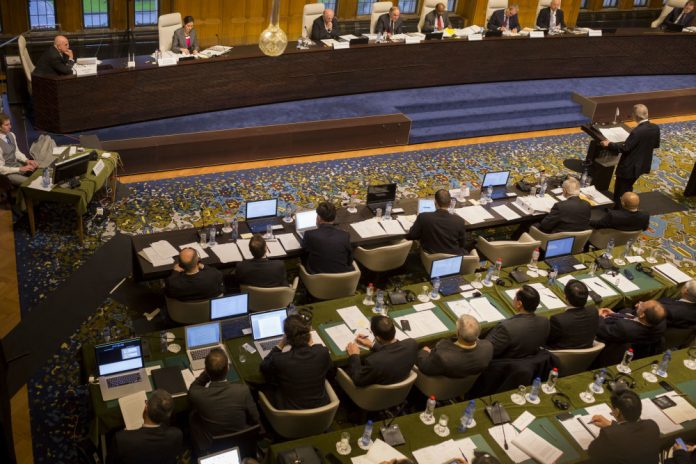This article has been written by Prasenjeet Sudhakar Kirtikar pursuing Diploma in Corporate Litigation and edited by Shashwat Kaushik.
This article has been published by Sneha Mahawar.
Table of Contents
Introduction
The court of law has been assigned powers to deal with the cases before it. Different powers are given to different kinds of courts or judicial bodies; e.g., the civil courts have the power to decide only on cases of civil nature. Such powers of a court of law to deal with matters are also called the jurisdiction of the court. Thus, the jurisdiction of a court is the power of that court to hear and determine the subject matter in controversy between the parties to the suit.
It is important to note that the court of law is conferred with such jurisdiction only according to a statute; e.g., the jurisdiction of the civil court is as per Section 9 of the Code of Civil Procedure of 1908, to try all suits of civil nature.
This article discusses how to interpret statutes that confer jurisdiction on the courts and the principles related to the interpretation of such statutes.
Meaning of jurisdiction
Jurisdiction means the authority or power by which a court can decide a matter as per the provisions of statutes. If a court declaring a judgement for any dispute does not have jurisdiction over such a dispute, then its judgement is null and can be ignored.
Types of jurisdictions
The jurisdiction can be of many types, as follows:
- Territorial jurisdiction: It defines the area within which the court of law can exercise its powers. For example, the High Court of Bombay has territorial jurisdiction over the states of Maharashtra and Goa.
- Pecuniary jurisdiction: It explains the extent of the amount of money involved in a dispute that a court can handle. E.g., a court of the Civil Judge Senior Division can handle cases with valuations up to 10 lakhs.
- Subject matter jurisdiction: This assigns specific matters to be dealt with by a court. E.g., civil cases must be handled by the civil courts only.
In addition to the above types, superior courts also exercise original jurisdiction, advisory jurisdiction, and appellate jurisdiction.
The jurisdiction of courts can be interpreted with the help of a few basic principles, which talk about the exclusion of jurisdiction, the jurisdiction conferred by common law, and specific statutes.
General principles affecting jurisdiction of courts
Exclusion must be explicitly expressed or clearly implied
This is the first and foremost principle related to the interpretation of the jurisdiction of courts. It simply means that if there is any exclusion or negation pertaining to the jurisdiction, then it must be very clearly explained in the provision and no ambiguity related to such an exclusion can be allowed.
Therefore, the exclusion of the jurisdiction of civil courts and conferring jurisdiction on tribunals for specific matters must be strictly construed.
E.g., Section 8 of the Family Courts Act of 1984 excludes the jurisdiction of civil courts when there is a family court.
In the case of H. H. Maharajadhiraja Madhav Rao … vs. Union of India (1970), the Supreme Court of India held that the people have a right, unless expressly or impliedly barred, to insist on free access to the courts of general jurisdiction. Also, the rule against exclusion of jurisdiction is applicable only when two or more constructions are possible and not where the legislative intent is clear.
Three classes of cases
It is the power of the legislature to confer the jurisdiction of civil courts partly or wholly on any other tribunal for the purpose of addressing specific subject matter.
Such legislative power can be exercised by enacting specific statutes for assigning jurisdiction to any particular tribunal by completely keeping aside or in parallel to the jurisdiction of civil courts conferred by the common law.
According to Willes J., there are three classes of cases in which liability might be established, founded upon the statutes.
- When the liability is affirmed by a statute that provides a special form of remedy but is different from the remedy provided in the common law, unless the statute contains words that expressly or by necessary implications exclude the common law remedy, the parties suing have the option to pursue either of the remedies.
- When the statute gives the right to sue only and provides no remedy, then the party can only proceed as per the common law to avail of any possible remedy.
- In other words, it simply means that between the statute and the common law, if only the common law is providing the remedy, then the party can proceed with the common law and thus, there will be no confusion. When no liability exists under the common law but is created by a statute that also provides for special remedy, then such remedy by the statute must be followed.
In the case of The Premier Automobiles Ltd. vs. Kamalakar Shantaram Wadke (1973), the Supreme Court of India held that if an industry dispute relates to the enforcement of any right or an obligation under the Industrial Disputes Act, 1947, then the only remedy available is to get adjudication under this Act and not any other act.
Cases of breach of statutory duties
Whether a statutory duty gives rise to a private law cause of action depends upon the construction of the relevant statute. The Supreme Court of India has accepted the rule that where a specific remedy is provided, it deprives the person who insists upon any other remedy. For example, if a penalty is provided for a breach of statutory duty as per a statute, then it may be regarded as the only way of enforcing the duty.
The general principle is that the remedy provided by the Act that creates obligations is exclusive and is not without exception. Out of general rule and exception, which will prevail in a particular case depends on the scope and language of the act.
In the landmark case of Black v. Fife Coal Co., Ltd. (1908), the House of Lords held that the penalty clause of the Coal Mines Regulation Act, 1887, does not take away the rights of injured persons as per the Act and they can also enforce civil liability against the employer.
Let us try to understand how to interpret the extent to which the exclusion of jurisdiction can occur and what elements can be helpful in such interpretation.
The extent of exclusion
The extent of exclusion can be interpreted with the help of the following three elements:
Construction of exclusionary clauses
The court of law must refer to the clause specifically talking about the exclusion without any ambiguity. Any other construction contrary to the clause would lead to nullity.
In the case of United Bank of India vs. Debts Recovery Tribunal and Ors. (1999), it was held by the Supreme Court of India that with the object of speedy adjudication of certain matters that are widely defined, the jurisdiction is conferred on tribunals and the jurisdiction of normal courts is excluded, so the wide language used can’t be narrowly construed.
Cases of nullity
This basically talks about the cases in which an order passed by a tribunal can be held null. This issue was addressed by the Apex Court in Smt. Ujjam Bai vs. State of Uttar Pradesh (1961). The Supreme Court of India held that an adjudication by a tribunal is void if:
- Action is taken under an ultra vires act.
- The subject matter is beyond its competence and it has no authority to pass the order.
- Jurisdiction is assumed by wrongly deciding jurisdictional questions of law or fact.
- Adjudication is in violation of fundamental principles of judicial procedure.
Rule of conclusive evidence
The legislation has the power to enact a statute to declare something as conclusive proof to such an extent that it becomes a non-justiciable matter.
E.g., if a legislative enactment proof of A is made conclusive evidence of B, then the court is bound to consider the existence of B the moment it realises the existence of A. Such evidence cannot be questioned in court as it becomes conclusive evidence.
In the case of Lilavati Bai vs. The State of Bombay (1957), the Supreme Court of India held that the Bombay Land Requisition Act empowers the state government to requisition any building if the owner or tenant is not residing in the building for a continuous period of six months and the state government can make a declaration for such a requisition. In this case, the declaration so made is conclusive evidence.
Along with the above conditions, it is also pertinent to understand some presumptions as to the jurisdiction of courts when encountering international regulations.
Presumptions regarding the jurisdiction of courts
- In the process of interpreting any municipal law, if it is found that such interpretation is in conflict with any international law, then the court will not give it such an effect.
In the case of Kesavananda Bharati.. vs. The State of Kerala and Anr. (1973), the Chief Justice of India, Sikri, observed that according to Article 51 of the Constitution of India, we must foster respect for international law and treaties.
- There is a presumption that an Act of Parliament generally applies within its territory only unless provided otherwise. However, in the case of A.H. Wadia vs. Commissioner of Income Tax (1948), the Bombay High Court held that in the case of a legislature, the question of extra-territoriality of enactment can never be raised in the municipal court as a ground for challenging its validity. The legislature may not recognise the rules of international law, but these are the questions of policy with which domestic courts are concerned.
- The jurisdiction of superior courts is conferred by the Constitution of India and not by any statutory enactment. Hence, it cannot be taken away by simply enacting a statute. It is also important to note that the appellate and revisional jurisdiction of superior courts should not be mistaken for being excluded simply because the subordinate courts enjoy special jurisdiction.
Conclusion
In India, there are various statutes in operation to decide on the jurisdiction of various courts and tribunals, e.g. Family Courts Act for Family Court, Income Tax Act for Income Tax Tribunal, etc. Due to the complexity of the judicial system, it has become necessary to interpret the statutes with care not to offend the jurisdiction of other authorities and also to avoid nullity.
The efficient observance of principles for interpreting the jurisdiction of courts will definitely help avoid loss of time and money. Moreover, it is also important to understand the jurisdiction of superior courts as conferred by the Constitution of India and one must not confuse it with the exclusion of jurisdiction.
References
- Principles of Statutory Interpretation” a book by Justice G. P. Singh.
- “Interpretation of Statutes” a book by Prof. Bhattacharya.
- https://blog.ipleaders.in/rules-interpretation-statutes/
- https://taxguru.in/corporate-law/rules-interpretation-statutes.html
- https://www.everycrsreport.com/reports/97-589.html
Students of Lawsikho courses regularly produce writing assignments and work on practical exercises as a part of their coursework and develop themselves in real-life practical skills.
LawSikho has created a telegram group for exchanging legal knowledge, referrals, and various opportunities. You can click on this link and join:
Follow us on Instagram and subscribe to our YouTube channel for more amazing legal content.
 Serato DJ Crack 2025Serato DJ PRO Crack
Serato DJ Crack 2025Serato DJ PRO Crack











 Allow notifications
Allow notifications



